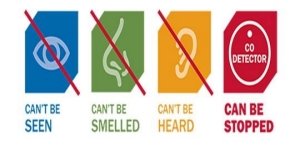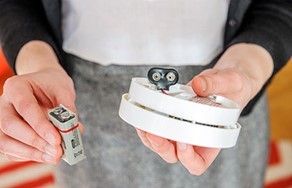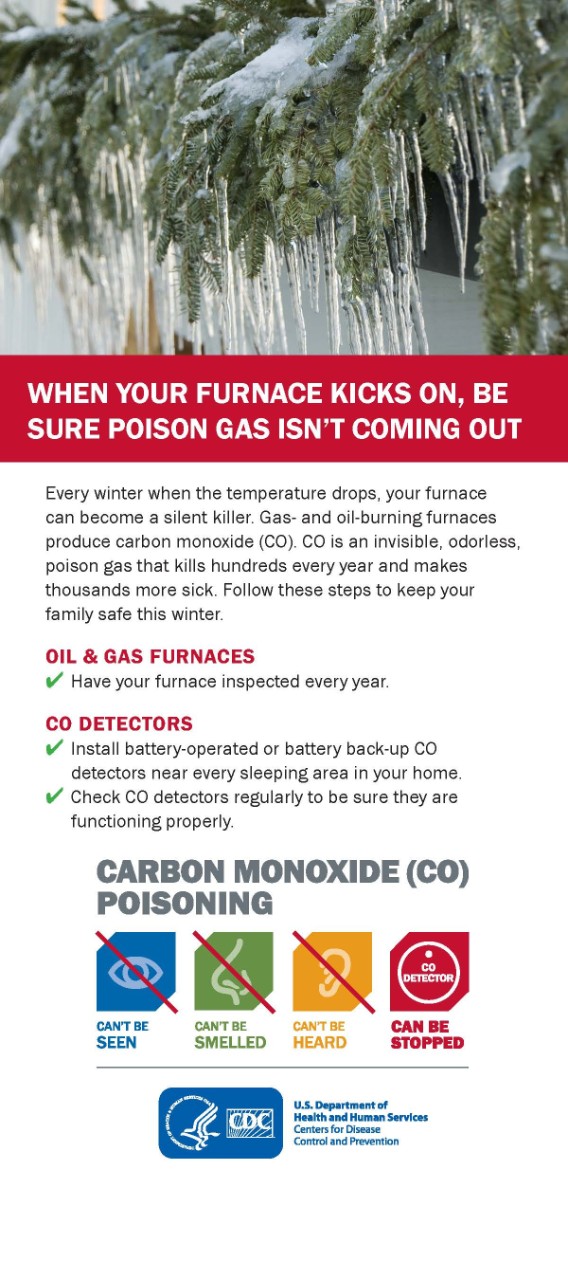Choose Safe Places: Carbon Monoxide


What is carbon monoxide?
Who is at risk from carbon monoxide poisoning?
How are people exposed to carbon monoxide?
What are the symptoms of carbon monoxide poisoning?
What should be done if you suspect someone has carbon monoxide poisoning?
How can I prevent carbon monoxide poisoning in my child care business?
How do I get a carbon monoxide detector?
How do I maintain my carbon monoxide detector?
Where can I find more information on carbon monoxide?
Additional resources
What is carbon monoxide?
Carbon monoxide, or CO, is a poisonous gas that cannot be smelled, seen or tasted, and can cause death in minutes if it is at high levels. Carbon monoxide can quickly build up to unsafe levels in enclosed or semi-enclosed areas.
Carbon monoxide is produced when fuel is not completely burned in:
- Any heating system, appliance, or equipment using gas, oil, wood, gasoline, propane, or kerosene
- e.g., some stoves, furnaces, fireplaces, grills, heaters, lanterns, generators, and yard equipment
- Cars, trucks, boats and other vehicles
Tobacco smoke is a significant source of carbon monoxide in buildings with smokers.
Roughly 50 percent of all carbon monoxide poisonings occur in the home, 40 percent are automobile related and 10 percent occur in work settings.
Who is at risk from carbon monoxide poisoning?
All people and animals are at risk for carbon monoxide poisoning. Certain groups may be more affected by carbon monoxide poisoning:
- Infants
- Children
- Unborn babies
- Pregnant women
- People with chronic heart disease, anemia, or respiratory problems
- People who already have elevated carbon monoxide blood levels, such as smokers
How are people exposed to carbon monoxide?
People may be exposed to unsafe levels of carbon monoxide when gas appliances are not working properly or when combustion gases are not being safely vented to the outside.
What are the symptoms of carbon monoxide poisoning?
Common symptoms are:
- Headache
- Dizziness
- Fatigue
- Nausea
- Vomiting
- Shortness of breath
- Chest pain
- Weakness
- Confusion
Breathing high levels of carbon monoxide can cause loss of consciousness and death. People who are sleeping can die from carbon monoxide poisoning before ever knowing they are being exposed to the gas.
What should be done if you suspect someone has carbon monoxide poisoning?
- Immediately get them outside to get fresh air. Call 911.
- If someone is unconscious and cannot be moved, open windows and doors to bring in fresh air. If known, turn off the source of carbon monoxide. Call 911.
Don't go back into the building until the problem has been resolved or the building has otherwise been cleared by emergency personnel
How can I prevent carbon monoxide poisoning in my child care business?
Carbon monoxide poisoning is preventable.
Some smoke detectors will aslo detect carbon monoxide, but many do not. Do not assume your smoke detector will alert you to carbon monoxide.
- Install a working carbon monoxide detector in your child care business. If your child care business occupies multiple levels or stories in a building, it is recommended to have one detector per level.
- Most are less than $30. If this presents a financial burden, please see the resources section below.
- Many carbon monoxide detectors easily plug into an electrical outlet and do not require mounting or other installation.
- If the detector goes off, get everyone out of the child care business immediately and call 911.
Below are some other DOs and DON’Ts to help prevent carbon monoxide poisoning in your child care business. Some may only be relevant to home-based child care businesses.
- DO:
- Have propane, kerosene and gas appliances and fireplaces, as well as wood stoves, checked every year by a trained professional.
- Keep generators outside and at least 15 feet away from your childcare buisiness.
- Have chimneys and flues are routinely checked and cleaned.
- DON'T:
- Run a vehicle in the garage, even with the garage door open.
- Use charcoal or gas grill in an enclosed space, such as inside your child care buisiness or garage.
- Use a generator inside your child care bsuiness, garage, carport, basement, crawlspace, or near an outside window, door, or vent.
- Burn anything in a stove or fireplace that is not vented.
- Have children nap while using an unvented gas or kerosene heater.
- Use unvented gasoline, propane, kerosene, or other fuel heaters.
- Use a gas range or gas oven to heat your building.

How do I get a carbon monoxide detector?
Carbon monoxide detectors are available to purchase at most home improvement stores and online retailers for less than $30. If this cost is financially burdensome to your business, licensed child care agencies may apply for a grant that will cover the cost of carbon monoxide detectors and other safety and security equipment. You can read more about the grant and apply at the link below:
Your local fire department may provide free carbon monoxide detectors. To find the contact information for your local fire department, click the link below:
Tennessee Fire Departments (January 2022)
How do I maintain my carbon monoxide detector?
- Replace batteries twice a year when you change the time on your clocks each spring and fall. Replace batteries even if your detector plugs into an outlet. These are backup batteries that allow the detector to continue working during power outages.
- Replace carbon monoxide detectors every 5-7 years. Carbon monoxide detectors have a lifespan of 5-7 years, some up to 10 years, before they lose a sense of smell and cannot detect the deadly gas accurately. When you purchase a carbon monoxide detector, take note of a "replace by" date that may be stamped on the side of the detector or mentioned in the user guide.
Where can I find more information on carbon monoxide?
You can read more about carbon monoxide on the Tennessee Deparment of Health's Healthy Homes- Carbon Monoxide website.
Additional resources
Tennessee Poison Center 1-800-222-1222
www.vumc.org/poison-control/home
Poison Control Center 1-800-222-1222
www.aapcc.org
Centers for Disease Control and Prevention
Carbon Monoxide Poisoning
www.cdc.gov/co/default.htm
ATSDR ToxFAQs
www.atsdr.cdc.gov/toxfaqs/tf.asp?id=1163&tid=253
US Environmental Protection Agency
Carbon Monoxide's Impact on Indoor Air Quality
www.epa.gov/indoor-air-quality-iaq/carbon-monoxides-impact-indoor-air-quality
Consumer Product Safety Commission (CPSC)
Carbon Monoxide Info Center
www.cpsc.gov/Safety-Education/Safety-Education-Centers/Carbon-Monoxide-Information-Center/
Tennessee Department of Health (TDH)
Carbon Monoxide Poisoning Prevention Checklist
English Spanish
